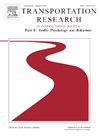Algorithmic management stressors and aggressive driving behavior: Roles of attentiveness and regulatory focus
IF 3.5
2区 工程技术
Q1 PSYCHOLOGY, APPLIED
Transportation Research Part F-Traffic Psychology and Behaviour
Pub Date : 2025-05-24
DOI:10.1016/j.trf.2025.05.021
引用次数: 0
Abstract
The rise of ride-hailing platforms has changed customers’ travel preferences and improved traffic efficiency. However, even though they are vital to ensuring customers’ safety and satisfaction, the roles of algorithmic management stressors in shaping ride-hailing drivers’ driving behavior are not well understood. This study draws on affective event theory to theorize how algorithmic management challenge and hindrance stressors manifest themselves in impacting aggressive driving behavior in the context of ride-hailing services. A time-lagged questionnaire survey design was used to collect data from 330 drivers working for ride-hailing services at four different time points. Latent mediation-moderation structural equation modeling was used to test the conceptual model. The results indicate that: 1) Algorithmic management challenge stressors undermine, while hindrance stressors promote, aggressive driving behavior. 2) Attentiveness mediates the indirect impacts of both algorithmic management challenge and hindrance stressors on aggressive driving behavior. 3) Promotion regulatory focus amplifies the indirect negative relationship that links algorithmic management challenge stressors through attentiveness to aggressive driving behavior. 4) Prevention regulatory focus amplifies the indirect positive relationship that links algorithmic management hindrance stressors through attentiveness to aggressive driving behavior. This study incorporates the aggressive driving behavior of ride-hailing drivers in the algorithmic era into road safety research by integrating the affective pathway of attention and drivers’ characteristics. The aim is to contribute to the understanding of the mechanisms and boundaries between algorithmic management stressors and aggressive driving behavior.
算法管理压力源和攻击性驾驶行为:注意力和监管焦点的作用
网约车平台的兴起改变了客户的出行偏好,提高了交通效率。然而,尽管它们对确保客户的安全和满意度至关重要,但算法管理压力源在塑造网约车司机驾驶行为方面的作用还没有得到很好的理解。本研究利用情感事件理论来理论化算法管理挑战和障碍压力源如何在网约车服务背景下影响攻击性驾驶行为。采用时间滞后问卷调查设计,收集330名在四个不同时间点为网约车服务工作的司机的数据。采用潜在中介-调节结构方程模型对概念模型进行检验。结果表明:1)算法管理挑战压力源破坏攻击性驾驶行为,阻碍压力源促进攻击性驾驶行为;(2)注意在算法管理挑战和障碍压力源对攻击性驾驶行为的间接影响中起中介作用。3)促进监管焦点放大了算法管理挑战压力源通过关注攻击性驾驶行为之间的间接负相关关系。4)预防监管焦点通过关注攻击性驾驶行为放大了算法管理障碍压力源之间的间接正相关关系。本研究将算法时代网约车司机的攻击性驾驶行为纳入道路安全研究,将注意力的情感路径与司机特征相结合。目的是帮助理解算法管理压力源和攻击性驾驶行为之间的机制和界限。
本文章由计算机程序翻译,如有差异,请以英文原文为准。
求助全文
约1分钟内获得全文
求助全文
来源期刊
CiteScore
7.60
自引率
14.60%
发文量
239
审稿时长
71 days
期刊介绍:
Transportation Research Part F: Traffic Psychology and Behaviour focuses on the behavioural and psychological aspects of traffic and transport. The aim of the journal is to enhance theory development, improve the quality of empirical studies and to stimulate the application of research findings in practice. TRF provides a focus and a means of communication for the considerable amount of research activities that are now being carried out in this field. The journal provides a forum for transportation researchers, psychologists, ergonomists, engineers and policy-makers with an interest in traffic and transport psychology.

 求助内容:
求助内容: 应助结果提醒方式:
应助结果提醒方式:


